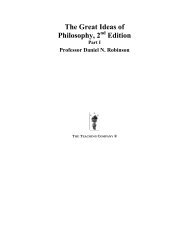English idioms in the first language and second language lexicon: a ...
English idioms in the first language and second language lexicon: a ...
English idioms in the first language and second language lexicon: a ...
You also want an ePaper? Increase the reach of your titles
YUMPU automatically turns print PDFs into web optimized ePapers that Google loves.
342 <strong>English</strong> <strong>idioms</strong> <strong>in</strong> <strong>the</strong> L1 <strong>and</strong> L2 <strong>lexicon</strong>decomposability goes toge<strong>the</strong>r with higher familiarity. The DIRModel argues that <strong>the</strong>re is a difference between frequency <strong>and</strong>familiarity <strong>and</strong> that high familiarity h<strong>in</strong>ts at a close relationship toconceptual structure (compare <strong>second</strong> <strong>and</strong> third assumptions).IV The central assumptions of <strong>the</strong> DIR ModelFirst, it should be noted that <strong>the</strong> DIR Model is a general modelthat is compatible with various, more concrete hypo<strong>the</strong>ses, forexample <strong>the</strong> graded salience hypo<strong>the</strong>sis (Giora, 1997; 1999; Giora<strong>and</strong> Fe<strong>in</strong>, 1999).The model is a heuristic representational approach,whereas <strong>the</strong> hypo<strong>the</strong>ses discussed at <strong>the</strong> beg<strong>in</strong>n<strong>in</strong>g of this articleare process<strong>in</strong>g hypo<strong>the</strong>ses. It is a fundamental question whe<strong>the</strong>r<strong>the</strong>re is a difference between representation <strong>and</strong> process<strong>in</strong>g.Usually <strong>the</strong> two terms are regarded as synonymous, because <strong>the</strong>manner of representation directly <strong>in</strong>fluences process<strong>in</strong>g. However,if one takes a closer look, assumptions about <strong>the</strong> mentalrepresentation of <strong>language</strong> should be located at an even moreabstract <strong>and</strong> ‘higher’ level than those about process<strong>in</strong>g. 4 The DIRModel postulates two levels of representation: a lexical <strong>and</strong> aconceptual one. 5 The <strong>first</strong> two assumptions discussed below dealwith lexical representations only <strong>and</strong> <strong>the</strong> third assumption refers to<strong>the</strong> conceptual level. The fourth assumption deals with differencesbetween <strong>the</strong> L1 <strong>and</strong> <strong>the</strong> L2 <strong>lexicon</strong>. The central question withregard to lexical representation is: Are <strong>idioms</strong> represented (<strong>and</strong>accessed) via <strong>the</strong> lexical entries of <strong>the</strong> <strong>in</strong>dividual constituents thatform each idiom or are <strong>the</strong>re separate lexical entries specify<strong>in</strong>g <strong>the</strong>idiomatic mean<strong>in</strong>g? The former are called constituent entries, <strong>the</strong>latter idiom entries.1 Idiom entries <strong>and</strong> constituent entriesFirst assumption: An idiom’s decomposability status determ<strong>in</strong>es itsmanner of representation. Nondecomposable, i.e., noncomposi-4Ano<strong>the</strong>r basic question concerns <strong>the</strong> relationship between conscious judgements of speakersabout <strong>language</strong> data <strong>and</strong> unconscious knowledge <strong>in</strong> <strong>the</strong> form of mental representations. It iscommon <strong>in</strong> l<strong>in</strong>guistics to assume that unconscious knowledge (competence) underlies <strong>the</strong>sejudgements (performance) <strong>and</strong> to <strong>in</strong>fer one from <strong>the</strong> o<strong>the</strong>r.5In this very broad sense, <strong>the</strong> usage of <strong>the</strong> term dual is <strong>in</strong> accordance with approaches likePaivio’s dual cod<strong>in</strong>g <strong>the</strong>ory (Paivio, 1971; 1986) ra<strong>the</strong>r than with Jackendoff’s (1989) external<strong>and</strong> <strong>in</strong>ternal concepts. Jackendoff assumes <strong>the</strong> conceptual level to be a subpart of <strong>the</strong>l<strong>in</strong>guistic level, whereas Paivio separates <strong>the</strong> verbal from <strong>the</strong> nonverbal system. Apart fromthat, Paivio’s approach is much more comprehensive than <strong>the</strong> DIR Model, which restrictsitself to <strong>idioms</strong>.Downloaded from http://slr.sagepub.com at Shanghai Jiaotong University on March 7, 2009














